
This article provides a convenient summary of portable and handheld spectroscopy techniques, outlining the most prominent types of compact instruments for both atomic and molecular spectroscopy.


This article provides a convenient summary of portable and handheld spectroscopy techniques, outlining the most prominent types of compact instruments for both atomic and molecular spectroscopy.

Industry leaders answer this question: In what area will spectroscopy see the biggest growth in the next five years?

A simple method for extraction and concentration of trace organic compounds found in water for gas chromatography-mass spectrometry (GC-MS) analysis was developed. The method used 25 and 45 mL glass vials with a 5-10 µm thick polymer coatings for extraction of analytes from 20 and 40 mL water samples, respectively. Analytes were subsequently transferred from the polymer coating into an organic solvent, which was reduced in volume to 200-400 µL for analysis. A 10-20 µL sample from the vial was transferred to a tiny coiled stainless steel wire filament using a micro-syringe, or by dipping the coil into the sample. After air evaporation of the solvent, the coil was inserted into the heated injection port of a portable GC-MS system where the analytes were desorbed. Injection using the coiled wire filament eliminated sample discrimination of high boiling point compounds, and minimized system contamination caused by sample matrix residues. The GC-MS contained a new resistively heated column bundle that allowed elution of low-volatility compounds in less than 4 min. Analyses of organochlorine pesticides, polycyclic aromatic hydrocarbons, polychlorinated biphenyl congeners, pyrethroid insecticides, phthalate esters, and n-alkanes in water and wastewater samples were accomplished for low ppb concentrations in less than 10 min total analysis time.

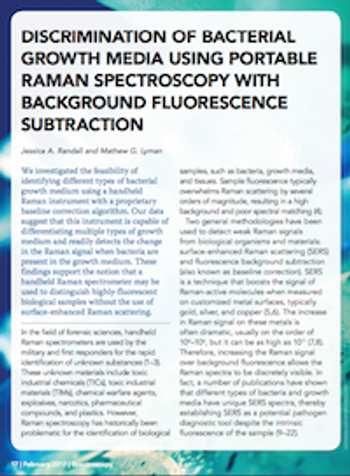
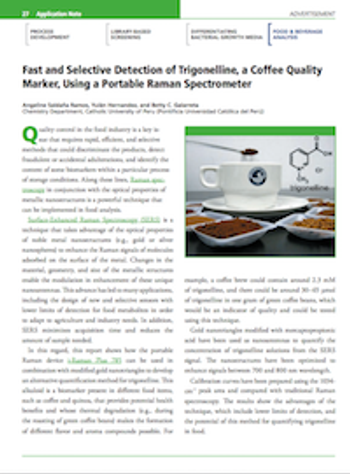
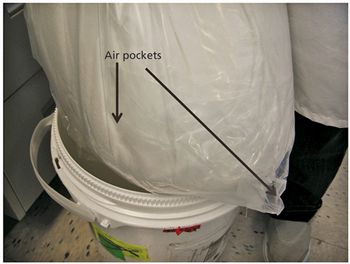
Portable instrumentation for Raman spectroscopy has rapidly evolved over the last decade, where sample testing that once occurred in the laboratory is now executed in the field (e.g. warehouse). Portable Raman spectroscopy is a powerful technique for the rapid identification of diversely sourced raw materials used in pharmaceutical processing. In addition to portability; reduced cost, rapid data acquisition and ease of use make this powerful technique attractive and accessible to both expert spectroscopists and non-specialists. In most cases, the method development can be easily accomplished in the laboratory after which the instrument and methods are transferred to field for sample analysis or warehouse areas for inspection of incoming raw material. Qualitative Raman methods for identification of raw materials typically utilize spectral libraries for sample to standard comparison. When developing Raman spectral libraries for raw material identification, great care is required when considering critical factors (e.g. instrument type, Raman capability, container type, container interference, background interference, material variability) that can potentially influence the identity of the material. This paper discusses portable Raman techniques and approaches for raw material identification, as well as key considerations for developing and validating Raman spectral libraries.
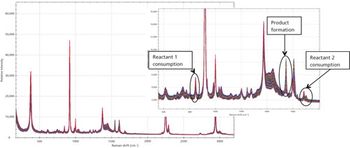
Raman spectroscopy is a well-suited spectroscopic technique for process development and control within development labs in chemical, pharmaceutical, and other industries. This article demonstrates the utility of portable Raman spectroscopy as a simple and versatile tool for in-situ monitoring of reactions using univariate analysis such as peak trending, as well as multivariate analysis approaches to predict the end point of chemical reactions. Using portable Raman systems allows users to make measurements in the lab, but also serves as a proof of concept for the Raman measurements to be implemented at-line or on-line in small pilot plants or large scale production sites. For known reactions that are repetitively performed, or for continuous online process monitoring of reactions, the present approach provides a convenient solution for process understanding and the basis for future implementation.
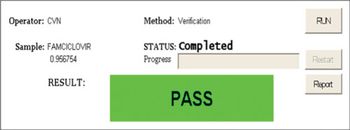
The availability of quality drugs is crucial in the event of a pandemic. Here, we report our pilot efforts to perform rapid screening of anti-infective drugs for confirmation of drug product quality using near infrared and Raman library methods. The methods reported are nondestructive towards the sample and are designed to facilitate rapid physical testing of drugs at the point of use or in a field setting. We built a representative library through voluntary collaboration with six different manufacturers of antibiotic and antiviral drugs. The drugs supplied by these manufacturers are representative of imported U.S. FDA approved finished products. We successfully transferred the spectral libraries from laboratory-based instruments to field-deployable handheld near infrared and Raman instruments and challenged the library methods using independent samples from different batches.
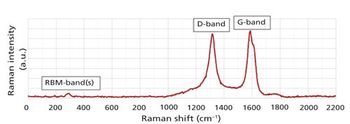
In this paper, we examine the relative performance of 532 and 785 nm portable Raman systems, as well as demonstrate an automated analytical methodology applicable for carbon nanotube (CNT) characterization and quality control applications. Both 532 and 785 nm Raman spectra were used to directly analyze and compare important CNT structural parameters and properties including CNT diameters, diameter distributions, CNT structural quality (% of defects), CNT types, and other properties. The data indicate advantages in a number of areas for using 532 versus 785 nm excitation for CNT Raman measurements.

Many automotive shops use a laundry service to clean their soiled shop towels. Previous studies have shown the towels can retain metals even after laundering and long-term exposure to certain metals such as lead could potentially result in health issues to employees using the towels. Laundered shop towels were collected from local automotive shops and analyzed to assess the ability of X-ray fluorescence (XRF) spectroscopy using a handheld system to measure harmful metal contaminants such as lead in the towels.
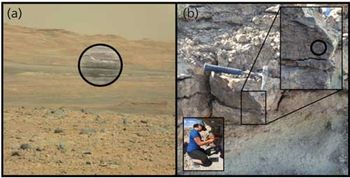
Visible-near infrared (VNIR) spectroscopy provides a wealth of compositional information, and is a valuable tool in planetary exploration. The 2016 GeoHeuristic Operational Strategies Testing (GHOST) program is a terrestrial analog rover simulation designed to refine Mars Rover operational strategies. The GHOST program utilized a TerraSpec Halo handheld VNIR spectrometer to simulate the function of the Mars Science Laboratory (MSL) ChemCam and Mars 2020 rover SuperCam. Commercially available instrumentation is employed to eliminate engineering, communication, and mission-specific specifications, and allow the GHOST team to focus solely on investigative protocols. The portable spectrometer allowed for rapid data acquisition of in-situ outcrops, similar to those data gathered by Mars rovers, and allowed the instrument operator to rapidly traverse the field site, maximizing the number of data points gathered for the science teams.
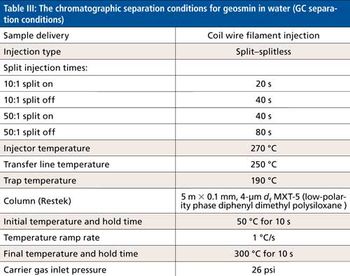
In this study we report on the use of a field-portable GC-MS with rapid sampling techniques such as solid-phase micro extraction, purge-and-trap, thermal desorption, and heated headspace to provide a fast response for in-field-SVOCs analyses for a wide variety of environmental-type samples including potable waters, tea, plants and road gravel. We will show that this field-portable approach can provide the required sensitivity, selectivity for the effective analysis of SVOCs with very high boiling points such as polycyclic aromatic hydrocarbon (PAHs), pesticides, phenolic compounds and phthalate esters in a number of different field-based samples, in less than 10 minutes.

Recent advances in Raman instrumentation have resulted in the development of easy-to-use and efficient handheld Raman analyzers. Most of the commercially available handheld Raman devices utilize 785 or 1064 nm excitation. This paper directly demonstrates the performance of 532 nm handheld Raman (versus 785 and 1064 nm) for the analysis of biopharmaceuticals for structure and counterfeit testing as well as explosive detection (TSA screening and CSI applications). The results presented here will contribute to recognition of 532 nm Raman excitation as a highly attractive option for a rapid “in-place” analysis in the field.

This installment describes the development of two novel X-ray diffraction (XRD) techniques that enable the rapid analysis of samples using handheld instrumentation for remote applications. Both techniques can be applied to unprepared samples in the field, which is a highly favorable characteristic in many applications since the time required for laboratory-based sample preparation is avoided.

An application of atomic spectroscopy for experiential learning through archaeological investigations is presented.
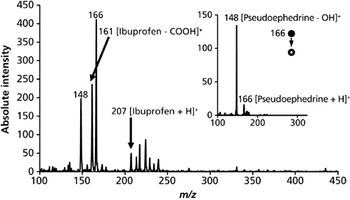
Worldwide trends in illicit drug use and production have shifted toward an increase in synthetic analogues and the emergence of new variations in their manufacture.
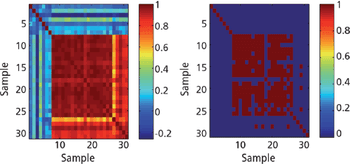
Counterfeit and illicit tobacco may contain potentially toxic organic impurities that result in adverse health effects to the consumer. The aim of this work was to investigate the feasibility of the identification of organic impurities in counterfeit or illicit tobacco using attenuated total reflectance-Fourier transform infrared (ATR-FT-IR) spectroscopy.

The Raman technique is gaining widespread acceptance as an investigative tool for forensic applications.

An interview with Vassili Karanassios, of the University of Waterloo in Waterloo, Ontario, Canada. His research focuses on micro- and nano-analysis and the development of miniaturized instruments for on-site applications.

Conventional pneumatic nebulizer-spray chamber combinations for ICP spectrometry have a sample introduction efficiency of only 1-3%. A unique electrothermal vaporization device developed by Vassili Karanassios of the University of Waterloo uses field-portable rhenium filament coils with a very small vaporization chamber and increases the sample introduction efficiency to 100%.
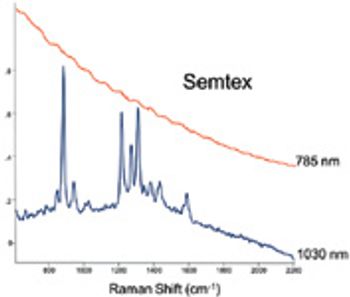
Handheld Raman analyzers have found widespread use in the pharmaceutical industry for excipients and raw materials verification, and in first responder/security applications. Most portable Raman units utilize lasers operating at 785 nm because of the relatively good signal strength at this wavelength.

Click here to view the complete Wavelength newsletter from August 20, 2013.

Handheld Raman spectrometers have been used to identify a variety of chemical materials, including toxic industrial chemicals, chemical warfare agents, explosives, narcotics, pharmaceutical compounds, and plastics. Researcher Mathew Lyman of the Chemical, Biological, Radiological Nuclear and Explosives Division at Oklahoma State University - University Multispectral Laboratories (OSU-UML) spoke to Spectroscopy about his and his colleague Jessica Randall's use of a handheld Raman spectrometer for identifying bacterial growth media.

A modern portable Raman instrument equipped with a 1064-nm laser is compared to one using a 785-nm laser for the identification of counterfeit pharmaceuticals.